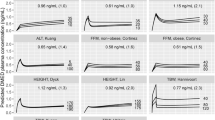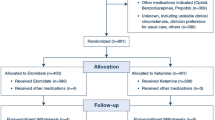Abstract
Purpose
Previous studies have demonstrated that amino acid infusions exert enhanced thermogenic effects during general anesthesia. This study was conducted to investigate whether amino acid infusions started after development of intraoperative core hypothermia can accelerate rewarming.
Methods
Twenty-two patients scheduled for major abdominal surgery were included in this study. When tympanic temperature reached 35.5°C, patients were randomly assigned to receive amino acids (amino acid group; n = 11) or saline (saline group; n = 11). A continuous infusion of a mixture of 18 amino acids or saline was started at 200 ml h−1. Tympanic, forearm, and digit temperatures were recorded. Forearm minus fingertip skin-surface temperature gradients (temperature gradient) were calculated. Postoperative shivering was also evaluated.
Results
Tympanic membrane temperature and temperature gradient were similar between the two groups at each time point during the study period. Temperature gradient at extubation in the amino acid group was significantly lower than in the saline group although tympanic temperature at extubation was similar between the two groups. Postoperative shivering score was significantly lower in the amino acid group than in the saline group.
Conclusions
Amino acid infusions started after development of intraoperative core hypothermia failed to accelerate rewarming. However, amino acid infusions reduced the incidence of postoperative shivering. Use of amino acid infusions to reduce thermoregulatory vasoconstriction at emergence might contribute to a decrease in the development of postoperative shivering.



Similar content being viewed by others
References
Schmied H, Kurz A, Sessler DI, Kozek S, Reiter A. Mild hypothermia increases blood loss and transfusion requirements during total hip arthroplasty. Lancet. 1996;347:289–92.
Kurz A, Sessler DI, Lenhardt R. Perioperative normothermia to reduce the incidence of surgical-wound infection and shorten hospitalization Study of Wound Infection and Temperature Group. N Engl J Med. 1996;334:1209–15.
Lenhardt R, Marker E, Goll V, Tschernich H, Kurz A, Sessler DI, Narzt E, Lackner F. Mild intraoperative hypothermia prolongs postanesthetic recovery. Anesthesiology. 1997;87:1318–23.
Frank SM, Fleisher LA, Breslow MJ, Higgins MS, Olson KF, Kelly S, Beattie C. Perioperative maintenance of normothermia reduces the incidence of morbid cardiac events. A randomized clinical trial. JAMA. 1997;277:1127–34.
Selldén E, Brundin T, Wahren J. Augmented thermic effect of amino acids under general anaesthesia: a mechanism useful for prevention of anaesthesia-induced hypothermia. Clin Sci (Lond). 1994;86:611–8.
Sessler DI, McGuyre J, Moayeri A, Hynson J. Isoflurane-induced vasodilation minimally increases cutaneous heat loss. Anesthesiology. 1991;74:226–32.
Matsukawa T, Sessler DI, Sessler AM, Schroeder M, Ozaki M, Kurz A, Cheng C. Heat flow and distribution during induction of general anesthesia. Anesthesiology. 1995;82:662–73.
Hynson J, Sessler DI. Intraoperative warming therapies: a comparison of three devices. J Clin Anesth. 1992;4:194–9.
Moher D, Schulz KF, Altman DG. The CONSORT statement: revised recommendations for improving the quality of reports of parallel-group randomised trials. Lancet. 2001;357:1191–4.
Kurz A, Sessler DI, Birnbauer F, Illievich UM, Spiss CK. Thermoregulatory vasoconstriction impairs active core cooling. Anesthesiology. 1995;82:870–6.
Aldrete JA. The post-anesthesia recovery score revisited. J Clin Anesth. 1995;7:89–91.
Baker KZ, Young WL, Stone JG, Kader A, Baker CJ, Solomon RA. Deliberate mild intraoperative hypothermia for craniotomy. Anesthesiology. 1994;81:361–7.
Jéquier E. The influence of nutrient administration on energy expenditure in man. Clin Nutr. 1986;5:181–6.
Selldén E, Bränström R, Brundin T. Pre-operative infusion of amino acids prevents postoperative hypothermia. Br J Anaesth. 1996;96:227–34.
Selldén E, Bränström R, Brundin T. Augmented thermic effect of amino acids under general anaesthesia occurs mainly in extra-splanchnic tissues. Clin Sci. 1996;91:431–9.
Selldén E, Lindahl SGE. Postoperative nitrogen excretion after amino acid-induced thermogenesis under anesthesia. Anesth Analg. 1998;97:641–6.
Chandrasekaran TV, Morgan RN, Mason RA, Mangat PS, Watkins AJ, Carr ND. Nutrient induced thermogenesis during major colorectal excision—a pilot study. Colorectal Dis. 2005;7:74–8.
Cheng C, Matsukawa T, Sessler DI, Ozaki M, Kurz A, Merrifield B, Lin H, Olofsson P. Increasing mean skin temperature linearly reduces the core-temperature thresholds for vasoconstriction and shivering thresholds in humans. Anesthesiology. 1995;82:1160–8.
Nishimura C, Kanemaru K, Otagiri T. Characteristic changes between core and peripheral surface temperature related with postanesthetic shivering following surgical operations. J Anesth. 1990;4:350–7.
Saitoh Y, Kaneda K, Tokunaga Y, Murakawa M. Infusion of amino acid enriched solution hastens recovery from neuromuscular block caused by vecuronium. Br J Anaesth. 2001;86:814–21.
Moriyama T, Tsuneyoshi I, Omae T, Takeyama M, Kanmura Y. The effect of amino-acid infusion during off-pump coronary arterial bypass surgery on thermogenic and hormonal regulation. J Anesth. 2008;22:354–60.
Acknowledgments
No conflict of Interest is included in this study. This study was supported by Department of Anesthesiology, Nara Medical University.
Author information
Authors and Affiliations
Corresponding author
About this article
Cite this article
Inoue, S., Shinjo, T., Kawaguchi, M. et al. Amino acid infusions started after development of intraoperative core hypothermia do not affect rewarming but reduce the incidence of postoperative shivering during major abdominal surgery: a randomized trial. J Anesth 25, 850–854 (2011). https://doi.org/10.1007/s00540-011-1230-4
Received:
Accepted:
Published:
Issue Date:
DOI: https://doi.org/10.1007/s00540-011-1230-4




